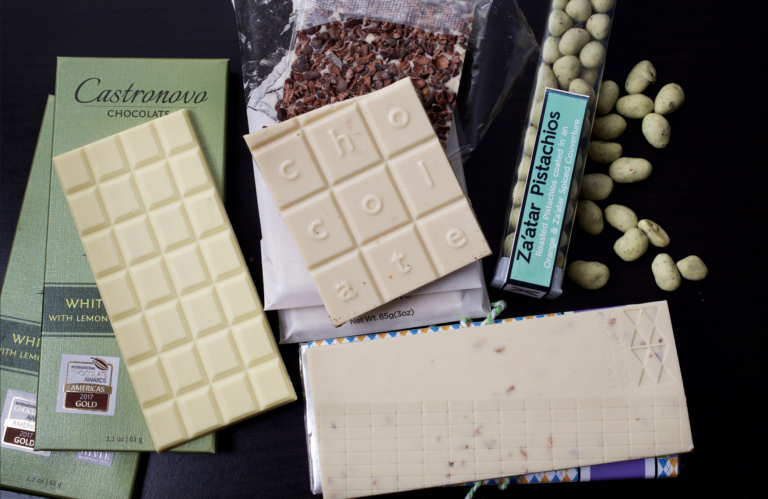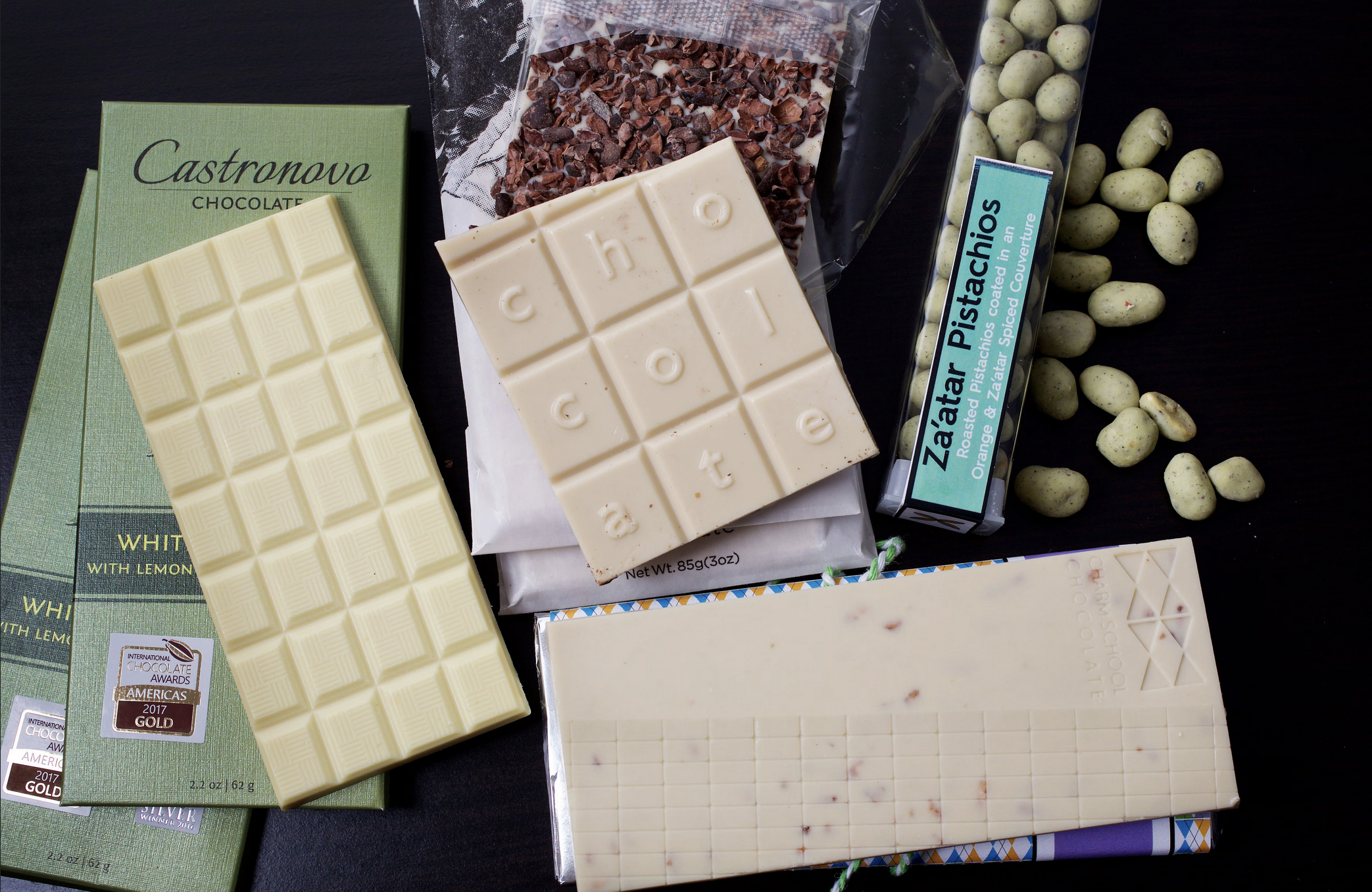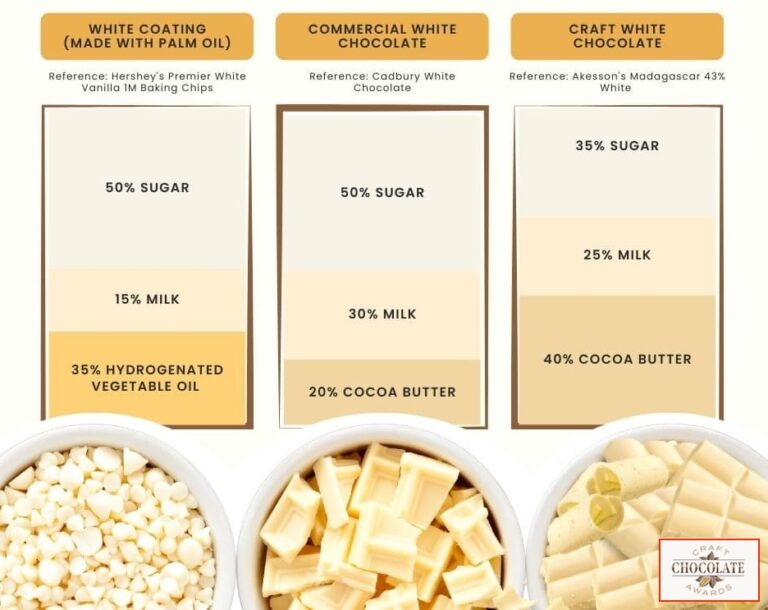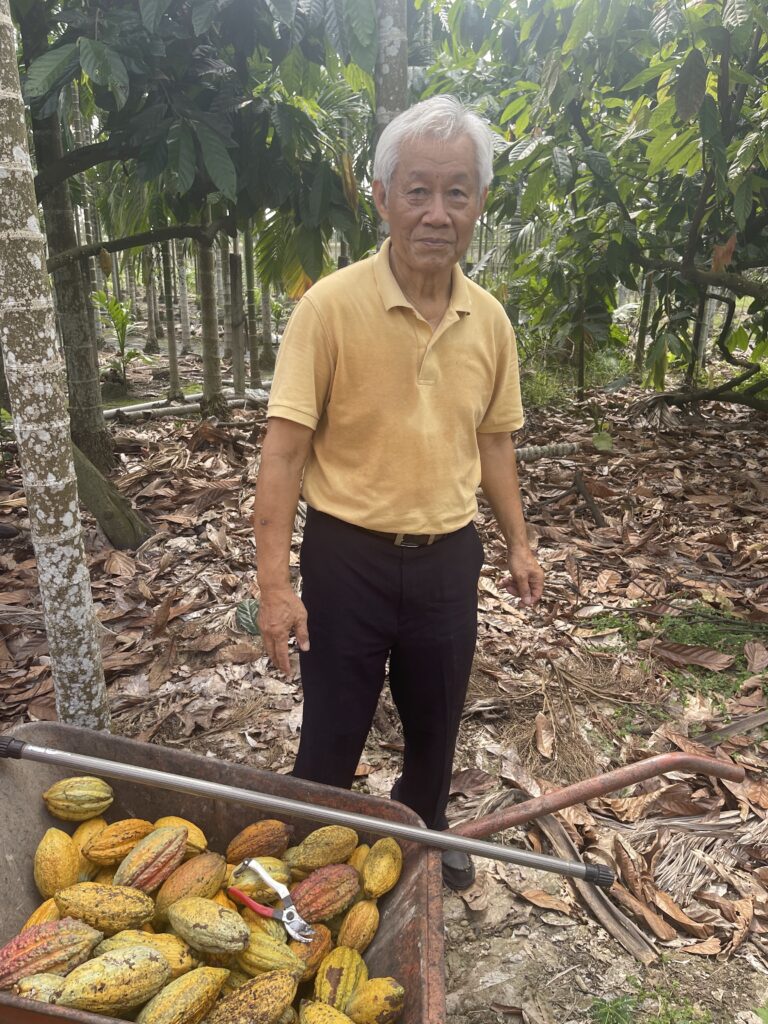
Best White Chocolate in the World
This article explores the origins and history of chocolate, tracing cacao’s use and cultural significance among ancient Mesoamerican civilizations like the Maya and Aztec. It
Best Chocolate > Best White Chocolates of 2023

White chocolate, often a subject of debate among chocolate enthusiasts, has taken center stage at the 2023 Craft Chocolate Awards. We have our very own Craft White Chocolate Award which recognizes the best white chocolate in the world which fully shows off the rich flavors in a bean’s cocoa butter. In the past few years, the world of craft chocolate has enjoyed an unprecedented boom in inventive and delightful flavor combinations fueled by the increasingly global and diverse world of craft chocolatiers and chocolate makers. While we were lucky enough to put dozens of white chocolate bars through our rigorous double-blind judging process, four exceptional white chocolate bars stood out, each earning a coveted gold award. These are, quite frankly, the best white chocolate bars in the world:
Amedi Toscana – Tuscan Pistachio: Amedi Toscana presents the Tuscan Pistachio, an Italian masterpiece combining the colors of the national flag with sheer audacity. The white chocolate serves as a canvas for the superb pistachios, evolving in flavor as the fruit matures within the chocolate. With hints of vanilla, honey, fresh milk, and pistachio, this creation is not only a treat but an experience, especially delightful during the summer months.
Wild Peaks Chocolates – Black Sesame Praliné: The Black Sesame Praliné by Wild Peaks Chocolates has emerged as a delightful companion to tea or coffee. Utilizing Valrhona white chocolate, renowned for its milky richness, the bar harmoniously blends with candied black sesame, lightly salted to perfection. The result is an addictive treat that captivates the taste buds.
AHERZ – Muzungu: AHERZ takes a unique approach with its Muzungu white chocolate bar, featuring the richness of whole vanilla beans from Madagascar. The meticulous process of slicing and scraping enhances the flavor, complemented by fine whole and skimmed milk powder. Austrian rock salt and cassia cinnamon add the finishing touches, creating a hearty white chocolate with a chocolaty aroma from untreated cocoa butter.
Chocolaterie A. MORIN – Tablette de chocolat blanc Pérou Chanchamayo 40% 100g: Chocolaterie A. MORIN’s creation, the Tablette de chocolat blanc Pérou Chanchamayo, offers a journey of flavors. Starting with warm milk and vanilla aromas, it progresses to notes of jasmine, yellow fruits, and raspberry. This bar showcases the intricate artistry of white chocolate, inviting chocolate lovers to savor a symphony of tastes.
Our international chocolate awards pay tribute to the obsessive, passionate individuals striving for chocolate perfection around the world. We honor renowned European chocolate houses who have perfected their bonbon and truffle recipes for generations alongside emerging bean-to-bar chocolate makers experimenting with bold ingredients like black currant and elderflower. During our blind tastings, we judge each craft chocolate bar and bonbon on its flavor, aroma, textures and craftsmanship to identify the best chocolate in the world.
See the winners +
To appreciate the artistry of these award-winning chocolates, it’s essential to understand the nuances of white chocolate. The legal definition of white chocolate in the United States includes a minimum of 20% cocoa fat, 3.5% milk fat, and 14% total milk solids. There is a fair degree of variation between countries as to what can legally be marketed as white chocolate but here the The Craft Chocolate Awards we require that our craft white chocolate bars meet more stringent requirements:
There are, however, a number of myths surrounding white chocolate. In reality, white chocolate emphasizes the importance of cocoa butter and critiques often stem from mass-produced “white chocolate” alternatives which lack true chocolate components. The best white chocolate brands know how to draw out the flavor and nuance from cocoa butter and often innovatively pair the chocolate with complementary flavors and infusions.
A decade ago even within the chocolate community some critics argue that white chocolate lacks cocoa solids and so it cannot be considered “real” chocolate, legal standards recognize it as chocolate, albeit with different compositional requirements. The complexity arises from the fact that the definition of chocolate varies between countries and regions, with each having distinct standards for cacao content and dairy content. The chocolate industry is continuing to evolve on this issue, with craft chocolate makers (as usual!) playing a leading pivotal role in reshaping perceptions about white chocolate.

The evolution of white chocolate goes beyond legal definitions. White chocolate has historically been dismissed by connoisseurs due to its unique composition, devoid of cocoa solids. However, a paradigm shift is occurring, with a growing number of craft chocolate companies dedicating the same attention to white chocolate as dark or milk chocolate. These chocolatiers are not only redefining the perception of white chocolate, but also addressing challenges associated with additives like palm oil, sweeteners, and fillers, which have tarnished its reputation.
The rise in price of cocoa butter, a key ingredient in white chocolate, has prompted some mass-market manufacturers to substitute a portion of deodorized cocoa butter with cost-effective (but inferior) fillers, impacting the quality of mass-produced white chocolate. This has led craft chocolate makers to take matters into their own hands, producing high-quality white chocolate that adheres to the true essence of the confection. Next time you are in the grocery store you can see the difference between the best white chocolate in the world…and mass market brands just by looking at the ingredients label. It’s gotten so bad that most mass-market brands can no longer even legally call their “white chocolate” white chocolate. Hershey’s (for example) no longer includes cocoa butter in their recipe at all, and rely on customer confusion when they label their “white chocolate” as Hershey’s White Creme… hoping that the consumer mentally and erroneously fills in the “chocolate” aspect themselves. Check out your local chocolatier for the real deal.
Cocoa butter, extracted from the seeds of the Theobroma tree’s fruit, serves as the fundamental essence behind everyone’s beloved chocolates, particularly in the realm of white chocolate.
The cocoa butter journey begins with the cocoa beans, the seeds harvested from the cacao or cocoa fruit. After undergoing meticulous processes of fermentation, drying, roasting, and crackling, the cocoa beans transform into cocoa nibs. These nibs are then ground down to form a thick paste known as cocoa liquor.
Through a rigorous pressing process, cocoa liquor undergoes separation, yielding cocoa butter—the luscious, edible fat that makes up approximately 55% of the bean’s weight. The solid content remaining after pressing is eventually processed into cocoa powder.
Cocoa butter comes in two main types: deodorized and non-deodorized.
This variant, stripped of its natural odors, is often preferred in cosmetics and white chocolate production destined for flavored or infused white chocolate bars. By removing the strong cocoa aromas chocolatiers can easily introduce complementary flavors like vanilla without interference.
Unrefined and natural, non-deodorized cocoa butter retains its distinctive pale-yellow color and the robust cacao flavor and aroma. This form of cocoa butter opens avenues for crafting the best single-origin chocolates, preserving the essential nutrients and antioxidants inherent in cacao beans. Its strong flavor, while enhancing the chocolate’s richness, may be avoided in recipes where it could overshadow other more subtle intended flavors.
When crafting dark and milk chocolate bars, cocoa butter is employed to enhance texture, providing a velvety and creamy mouthfeel. While mass-produced chocolate bars may use additives like lecithin to mimic this texture, artisanal chocolatiers, such as is used by all of our winners, rely on pure cocoa butter for its silky creaminess. The thermodynamic properties of cocoa butter contribute to the rapid melting of chocolates in the mouth, enhancing the overall tasting experience.
For chocolatiers creating an array of confections, cocoa butter is indispensable. It reduces viscosity, making the treats smoother and more enjoyable upon consumption. Cocoa butter’s unique properties aid in molding chocolates with ease, enriching glossiness, and creating captivating designs with vivid colors. The lighter nature of cocoa butter allows seamless blending with food colors for artistic presentations.
In the world of white chocolate, these award-winning bars represent not only exceptional craftsmanship but also a glimpse into the future of chocolate innovation. As consumers explore the diverse and creative offerings from craft chocolate makers, white chocolate is proving to be more than just a sweet treat—it’s a canvas for culinary artistry.


This article explores the origins and history of chocolate, tracing cacao’s use and cultural significance among ancient Mesoamerican civilizations like the Maya and Aztec. It

Embark on a journey through Taiwan’s lush Pingtung County, where 77-year-old Mr. Chou pioneers small-scale cacao farming, and award-winning chocolatier Jade Li transforms each harvest
Keep up-to-date on upcoming chocolate awards